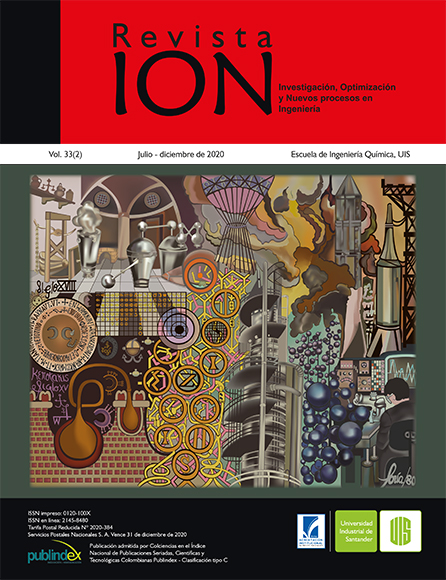Optimization of the process of obtaining a natural pine bark adsorbent
Published 2020-11-12
Keywords
- Tannins,
- Crosslinking,
- Adsorbent
How to Cite

This work is licensed under a Creative Commons Attribution 4.0 International License.
Abstract
The tannins present in the bark of Pinus patula have been extracted to develop an adsorbent through a crosslinking reaction, which occurs between the phenolic groups due to treatment with sulfuric acid, which is used as a crosslinking agent for polyphenolic groups present in the tannins. In the present study, the Box-Behnken design is used to maximize the performance of the crosslinking reaction and, therefore, to obtain the best mechanical properties of the prepared adsorbent. The response variable studied was the percentage yield of the reaction, and the independent variables evaluated in the Box-Behnken design included, Solid/Liquid ratio (grams of tannin/mL of H2SO4) (0.2-0.5 gmL-1), temperature (75-95 °C) and time (8-12 h). The verified statistical model estimates an optimal percentage yield of 73.81%, it is obtained with an S/L ratio of 0.499 gmL-1, temperature of 95 °C and reaction time of 10.45 h. The modification of the surface functional groups of the tannins was established by means of the IR spectra. The adsorbent had a BET surface area of 4.17 m2g-1.
Downloads
References
[2] Alvarez Godoy E. Aprovechando los Residuos Madereros (sitio en internet). Ecoportal. Disponible en: https://www.ecoportal.net/temas-especiales/educacion ambiental/aprovechando_los_residuos_madereros/. Acceso el 18 de julio 2020.
[3] Merle C, López O. Estudios de Economía forestal en el marco de la Misión de Crecimiento Verde en Colombia (sitio en internet). Disponible en: https://www.dnp.gov.co/Crecimiento-Verde/Documents/ejestematicos/forestal/Productosfinales/ResumenV2018-09-30.pdf. Acceso 14 de julio 2020.
[4] Gómez EA, Ríos LA, Peña JD. Madera, un Potencial Material Lignocelulósico para la Producción de Biocombustibles en Colombia. Inf. Tecnológica. 2012;23(6):73–86.
[5] Choudhary BC, Paul D, Borse AU, Garole DJ. Surface functionalized biomass for adsorption and recovery of gold from electronic scrap and refinery wastewater. Purif. Technol. 2018;195:260–270.
[6] Bacelo HA, Santos SC, Botelho CM. Tanninbased biosorbents for environmental applications - A review. Chem. Eng. J. 2016;303:575–587.
[7] Ogata T, Research YN. Mechanisms of gold recovery from aqueous solutions using a novel tannin gel adsorbent synthesized from natural condensed tannin. Water Res. 2005;39(18):4281–4286.
[8] Al-Qodah Z, Yahya A, Al-Shannag M. On the performance of bioadsorption processes for heavy metal ions removal by lowcost agricultural and natural by-products bioadsorbent: a review. Desalin Water Treat. 2017;85:339–357.
[9] Kavitha UV, Kandasubramanian B. Tannins for wastewater treatment. SN Appl. Sci. 2020;2(6):1081.
[10] Santos SC, Bacelo HA, Boaventura RA, Botelho CM. Tannin‐Adsorbents for Water Decontamination and for the Recovery of Critical Metals: Current State and Future Perspectives. Biotechnol. J. 2019;14(12):1900060.
[11] Gurung M, Adhikari BB, Kawakita H, Ohto K, Inoue K, Alam S. Recovery of Au(III) by using low cost adsorbent prepared from persimmon tannin extract. Chem. Eng. J. 2011;174(2):556–563.
[12] Arbenz A, Avérous L. Chemical modification of tannins to elaborate aromatic biobased macromolecular architectures. Green Chem. 2015;17(5):2626–2646.
[13] Sarria Villa RA, Corredor JA, Isabel Paez M. Isolation of Catechin and Gallic Acid from Colombian Bark of Pinus patula. Chem. Sci. J. 2017;8(4):174.
[14] Ospina Penagos CM, Hernández Restrepo RM, Rincón EA, Sánchez Ocampo FA, Urrego Mesa JB, Rodas Peláez C, et al. Guías silviculturales para el manejo de especies forestales con miras a la producción de madera en la zona andina colombiana. (Sitio en internet). CENICAFE. Disponible en: http://cia.corantioquia.gov.co/cgi-bin/koha/opacdetail.pl?biblionumber=11823: Acceso el 26 de agosto 2020.
[15] Alegria K. Determinación de la capacidad de adsorción de la resina de Pinus Patula modificada químicamente para retener cromo de efluentes generados por la actividad de
curtiembres. (Tesis pregrado). Popayán, Colombia: Universidad del cauca; 2017.
[16] O. Saravia JM, Cano T, Chavez, B, Cerezo E. Extracción y caracterización de taninos en corteza de 3 especies forestales cultivadas en Guatemala, pino ocote (Pinus oocarpa schiede), Encino negro (Quercus brachystachys benth) y aliso común (Alnus jorulensis hbk.). Una alternativa de desarrollo agroindustrial. (Tesis maestria). Guatemala. Instituto de investigaciones agronómicas. 2002.
[17] Rosángeles Hernández ME, Carrasco P, Mujica R. Evaluación de la capacidad de adsorción de desechos agroindustriales para la remoción de ácido acético. Rev. Fac. Ing., Univ. Cent. Venez. 2007;22(3):31-46.

